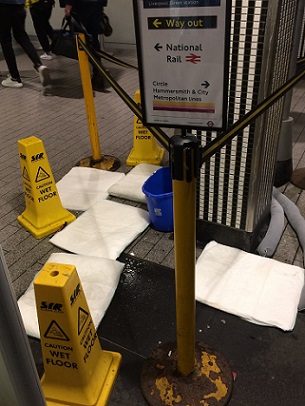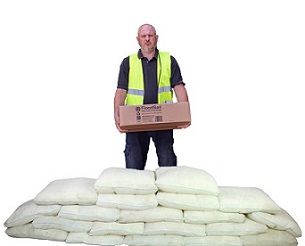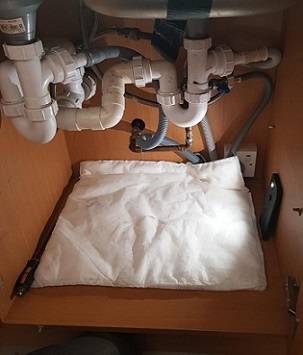 FloodSax deployed on the London Underground to stop people from slipping and falling
FloodSax deployed on the London Underground to stop people from slipping and falling
 All these 20 FloodSax came from this one easy-to-carry box
All these 20 FloodSax came from this one easy-to-carry box
 FloodSax soaking up leaks and spills under a sink
FloodSax soaking up leaks and spills under a sink
London boroughs stock up with FloodSax alternative sandbags as vital flood prevention
Several London boroughs have stocked up with an alternative sandbag after seeing at first-hand the devastation caused by flash floods.
The capital was deluged by flash floods twice in a week during the summer of 2021 and again last month, causing millions of pounds water damage to homes and businesses.
Now many people, including several London boroughs, are using an alternative sandbag called FloodSax as it’s far more space-saving to store than traditional sandbags, easier to deploy and more robust against floodwater.
Known as the sandless sandbag, the FloodSax is a British invention now used worldwide. It has a large, ultra-flat surface area when dry so can be used inside buildings to soak up leaks and floods and when immersed in water the gelling polymer inside absorbs the water and retains it, transforming the FloodSax into an instant sandbag but without any sand.
It was invented by Richard Bailey, managing director of Yorkshire-based Environmental Defence Systems Ltd, who said: “A few London boroughs have used FloodSax for a while now but we have seen a sharp increase in orders from other boroughs in the wake of the terrible recent floods which have showed the tremendous power of water and the destruction it can cause.
“Water wrecks everything and with so many basement and ground-flood flats at risk in London the danger they will become flooded is ever present. People think councils will come to save them with sandbags if imminent flooding is forecast but that’s simply not the case. Councils have absolutely no responsibility to provide sandbags to anyone. People must protect their own homes and businesses.”
Insurance giant Zurich recently warned that almost half of London’s businesses are now at risk from flash flooding.
It says flash floods could swamp 42% of the 301,000 commercial buildings in the capital with 33,200 commercial basements especially at risk.
A report in Insurance Business UK revealed that research has discovered the area in London most vulnerable is Kensington and Chelsea with 63% of its commercial properties in danger from flash flooding.
Other high risks boroughs include Hammersmith and Fulham at 56%, Merton and Southwark at 54% and Wandsworth at 53%.
In the wake of the two major flash flooding incidents in London in July 2021 it was revealed that almost half of hospitals, one in five schools and a quarter of London’s rail stations are at risk of flooding.
The statistics revealed by City Hall also say around 200,000 homes and workplaces are at medium or high risk of surface water floods.
Hackney, Brent, Tower Hamlets, Newham, Islington, Hammersmith and Fulham are all at particularly high risk of flooding.
The Underground has used FloodSax alternative sandbags to deal with floods on its network, especially those parts used by passengers where water can cause health and safety problems such as the risk of slipping.
For more information on FloodSax and how versatile and multi-purpose these alternative sandbags can be, go to http://www.floodsax.co.uk/